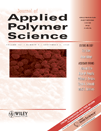New approach to antibacterial treatment of cotton fabric with silver nanoparticle–doped silica using sol–gel process
Abstract
In this study, cotton fabric was successfully modified to have an antibacterial property through use of the sol–gel process. Dodecanethiol-capped silver nanoparticles, which have powerful antibacterial activity, were incorporated in silica sol. The starting materials were silver nitrate, tetraoctylammonium bromide, sodium borohydride, chloroform, 1-dodecanethiol, ethanol, tetraethylorthosilicate, and water. The cotton fabric was padded with dodecanethiol-capped silver nanoparticle–doped sol, dried at 60°C, and cured at 150°C. Scanning electron microscopy showed a uniform and continuous layer of doped sol on the fiber surface. The antibacterial effects of the treated cotton fabric against Escherichia coli were examined and found to be excellent. © 2006 Wiley Periodicals, Inc. J Appl Polym Sci 101:2938–2943, 2006




